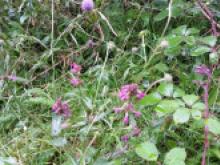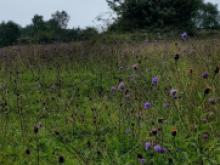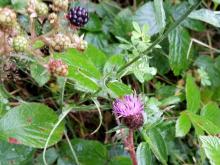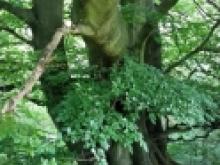My walk didn't exactly go as planned yesterday. The forecast that I heard was for a dry day and while walking steeply uphill from Oakamoor towards Golden Hill Farm it did feel pretty warm. The views from near the top are spectacular and a reward for the calorie burning exertion.
Near the top was my first change of plan, thanks to a bull and his gals. They're magnificent beasts but being frisky about the idea that my dog and I were about to cross their field. I'm pretty hardy, and the bull looked cute, but the youngsters were hoofing about looking for entertainment. A change of route was required - luckily I was able to be flexible.
So we find ourselves at the top end of Cotton Dell when a heavy shower starts. We shelter under a large tree and make a note to ask CVLLP's Ian Kynaston if grand old beech trees make as good a habitat as a veteran oak, for example. Nothing much grows underneath beech trees, so does anything choose to live on or in them?
Looking out across the meadow, which I believe is a SSSI, I had time to spot all the different purple and blue species. This meadow is looking magnificent, even in the rain.
A further change to the route had us sloshing along the wet path through Cotton Dell to shorten the walk in view of the weather. The walk was shorter and wetter than planned, but lovely all the same.






Comments
yes beech trees are more or